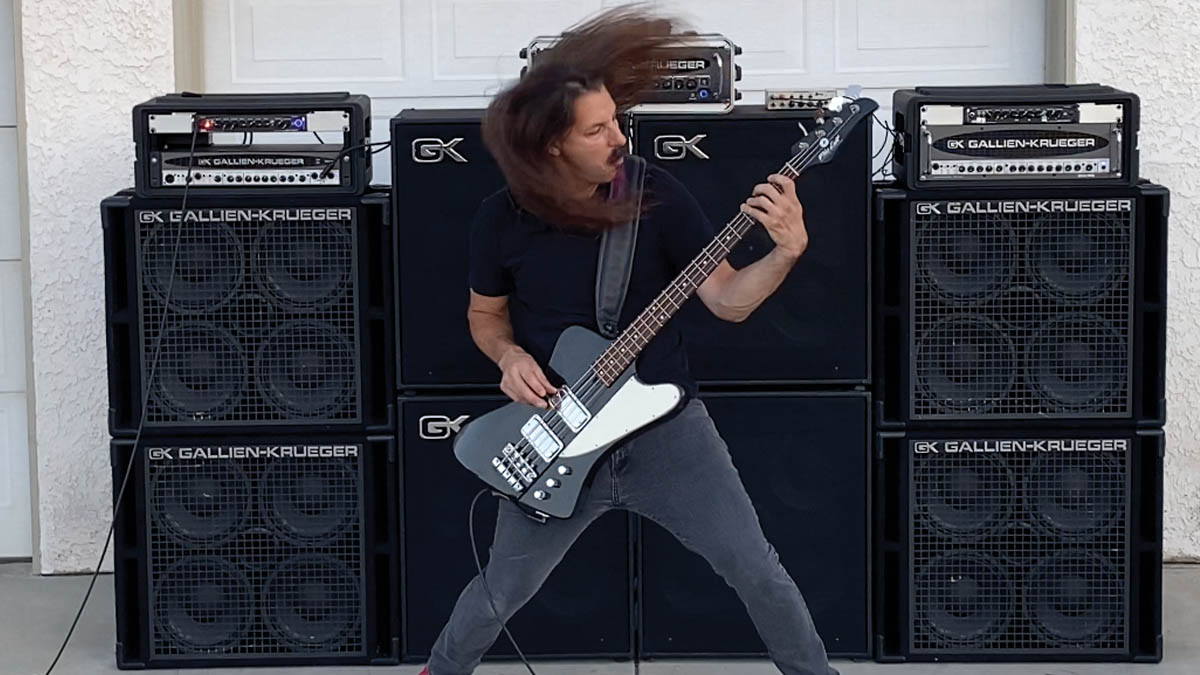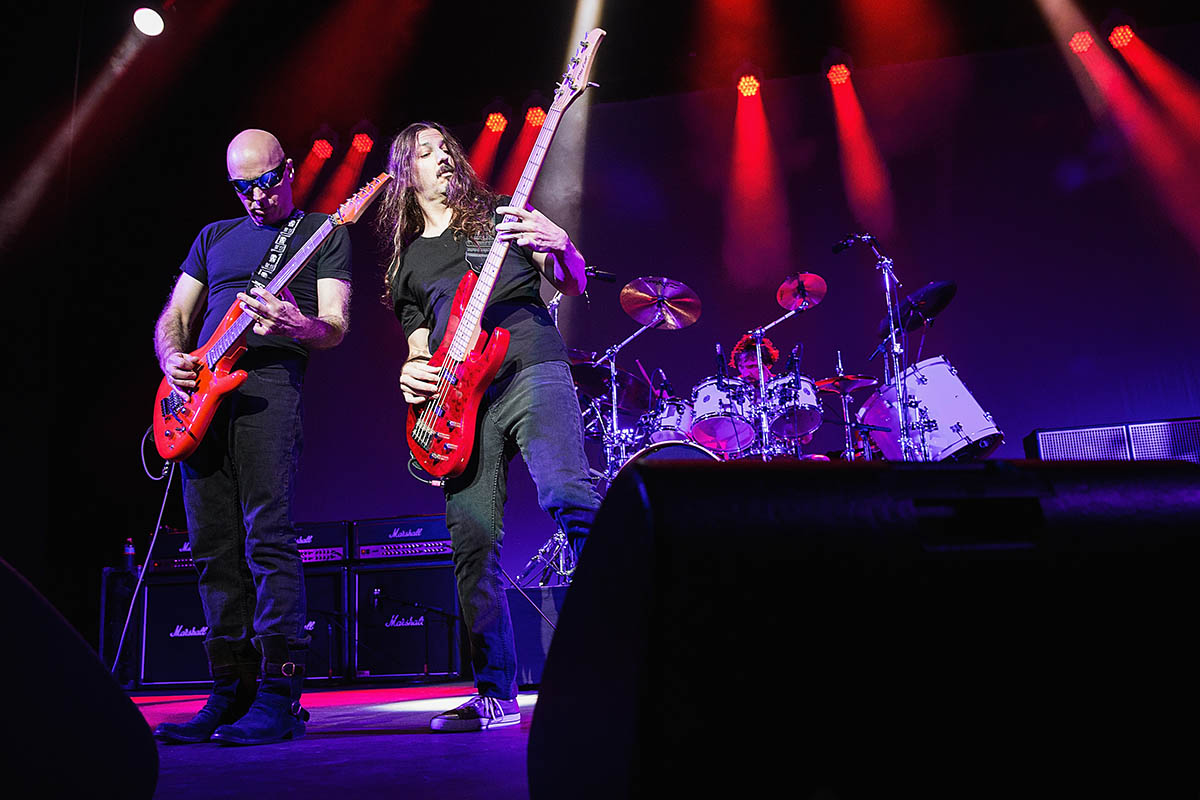Bryan Beller on the search for the perfect bass and thinking visually when songwriting
The Aristocrats and Joe Satriani bass phenom unpacks his epic pedalboard, and explains the importance of video in music today

Bryan Beller does so many bass-related things so well and so prolifically that he puts the rest of us to shame. Listen up, as he tells us about his commentary on the absurd world in which we find ourselves in 2021...
Bryan, you recently released a video for A Quickening/Steiner In Ellipses to YouTube. How did you approach it?
“Rather than make a video for a nine-minute prog epic, which people could easily miss in their social media feeds because it takes a good 30 seconds or a minute to get started, I thought, ‘Let’s make art marry practicality here’ and chose two short songs to make videos. A Quickening and Steiner In Ellipses are both two minutes long, they segue into each other on the album, and they start instantly, so they were perfect for a video in these instant-attention times.“
You insert comments from social media users into the video, making it a very meta piece of work.
“Definitely! All social media is about people putting stuff in the box, and the box giving them feedback. I wondered if I could make a commentary on people doing so much on social media, because so many people create things and put them out to the silent Greek chorus. That’s not really me, because I tend to sit back and watch the landscape unfold.“
Believe me, if I had an unlimited amount of money, I would do videos for every song on the album, and I would also put on a live show that included a video for every song
What role do videos such as this one play in your career as a musician?
“Well, when Covid happened, the idea of having content online went from being a small part of what you do as a touring musician to being everything that you do – because all there is is creating content, putting it out there, and hoping that it will attract attention. I wanted to put something out there that has a deeper message than just entertainment.
Get The Pick Newsletter
All the latest guitar news, interviews, lessons, reviews, deals and more, direct to your inbox!
“Believe me, if I had an unlimited amount of money, I would do videos for every song on the album, and I would also put on a live show that included a video for every song. I envisioned the album as a series of scenes, which is why it’s called Scenes From The Flood. There are visual stories for each song, with a narrative and a sub-narrative.“

Talk us through your go-to bass gear.
“I’m really careful about only endorsing stuff that I really like. I started playing through Gallien-Krueger amps in 2011, and I’m really glad that I did, because the G-K gear has that hi-fi sound but responds really fast.
“You can feel it more immediately in your fingers, and it creates more headroom and more opportunities to execute dynamics. So I’ve been an avid G-K user for all my live needs since 2011, without exception. Obviously when you do fly dates to South America, you take whatever gear you get!“
How do you set up the live rig?
“I use the original MB Fusion head as a preamp and I send audio out to two 2000 RBs, which I just use as power amps. Ideally, I’ll then send those to four 4x10 cabs, and those can either be the entry-level CX cabinets, which have a really warm punch to them, or the RBHs, which are the massive, pro cabs with the wedge-shaped back. You need those if you’re going to be on stage with Dethklok or Joe Satriani. 4,000 watts, and that preamp does the job perfectly.“
How about basses? You’ve been seen with a wide range of instruments, not least in your new video.
“As far as basses are concerned, I’ve been a Mike Lull guy since 2000. I’ve been playing an active M5 five-string with an ash body and maple neck, which is kind of a signature thing for me, for a long time, and then I also have a passive PJ Lull five with an alder body and a rosewood fingerboard, which gives you the completely opposite sound.
“In recent years I’ve been exploring a warmer sound, by which I mean a little bit more compressed, midrangey, and modern than the classic sound which the Lulls give me, so I started getting into Spectors.
“I have a couple of those now, and they’re neck-through, so they don’t set up quite the same way as a bolt-on, and I can get very specific with a bolt-on about my action and setup. Neck-throughs also sound different, with a deeper low-end, which objectively sounds a little better.“
In recent years I’ve been exploring a warmer sound, by which I mean a little bit more compressed, midrangey, and modern
Which Spectors did you try out?
“I bought an Alex Webster signature, which has an alder body with an ebony fingerboard and most importantly, EMG electronics – the complete opposite of the Fender and Mike Lull world. It’s a great bass, but the string spacing is a little small for me, and for that reason it always felt a bit weird, even though it sounded great, so I ended up trying to find a bass that would sound like Alex’s Spector, but would feel like a Mike Lull.
“The truth is that those two things can’t really meet, because a bass is either a neck-through or not. The closest I got was to work with Mike on a signature model, the Modern Focus BBMF5. It’s alder with a maple top, an ebony fingerboard, EMG DC40 pickups, and the BQC preamp. Those three are my live basses. I also use a Spector Forte 5 for recording. I use D’Addario Pro Steels strings and have done since 1996.“
And what about effects?
“I have a very set pedalboard. In fact, I have two duplicates, one on a big Pedaltrain Pro and one on two separate boards joined with cables, so you can fold it in half and put it into a flight case. It weighs under 50 pounds, so you can do fly dates with it.
“Either way, it starts with a volume pedal, then a tuner. The first effects pedal is a Boss OC-2 octaver – often imitated, never duplicated! – and my main overdrive, an Xotic Effects Bass BB preamp, which I’ve been using for 20 years.
“There’s a DigiTech Bass Driver right behind that, which is not particularly sophisticated but which gives me some creamy distortion in the second stage, and then a third overdrive stage which I don’t combine with the others, because I use it for a pick sound; it’s a Darkglass Vintage Deluxe with an Aphex Bass Exciter right behind it. They go together.“
To me, the Electro-Harmonix Bass Microsynth is still the only live bass synth that actually projects and preserves fundamentals when there’s live drums and guitars going off
“After the overdrive stage, you get to an Electro-Harmonix Bass Microsynth, which to me is still the only live bass synth that actually projects and preserves fundamentals when there’s live drums and guitars going off. I swear by it, because it sounds amazing.
“Then you get into filters: I have a Dunlop bass wah, and in the modulators I have a TC Electronic Hall Of Fame Reverb, a TC Flashback Delay set to a very specific Dave Gilmour setting, and then the Boss DD-3 delay, the old white one. Then there’s a Boss Bass Chorus CE-2B, from the '80s.“
What are your plans for 2021, if any?
“Well, there’s a Joe Satriani tour on deck as soon as we can tour again – I have my fingers crossed for later this year on that. There’s also an Aristocrats live album dropping pretty soon. Generally, it’s hard to predict the future at the moment, right?“
- Bryan Beller's Scenes From The Flood is out now via Onion Boy.
Bass Player is the world’s most comprehensive, trusted and insightful bass publication for passionate bassists and active musicians of all ages. Whatever your ability, BP has the interviews, reviews and lessons that will make you a better bass player. We go behind the scenes with bass manufacturers, ask a stellar crew of bass players for their advice, and bring you insights into pretty much every style of bass playing that exists, from reggae to jazz to metal and beyond. The gear we review ranges from the affordable to the upmarket and we maximise the opportunity to evolve our playing with the best teachers on the planet.
“I was playing stuff I don’t think James Brown understood. He told me, ‘You have to play the one – you’re playing too much’”: Six years after he quit touring, Bootsy Collins reflects on James Brown and George Clinton, and what he gets out of playing today
“When I first heard his voice in my headphones, there was that moment of, ‘My God! I’m recording with David Bowie!’” Bassist Tim Lefebvre on the making of David Bowie's Lazarus









![[from left] George Harrison with his Gretsch Country Gentleman, Norman Harris of Norman's Rare Guitars holds a gold-top Les Paul, John Fogerty with his legendary 1969 Rickenbacker](https://cdn.mos.cms.futurecdn.net/TuH3nuhn9etqjdn5sy4ntW.jpg)
